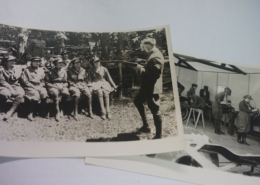18th Century Double-Barreled Pistol Discovered During Dig on Historic Tudor Place Grounds
Press Contact:
Heather Bartlow, hbartlow@tudorplace.org
202.965.0400 ext. 104
Website: https://tudorplace.org/
Tudor Place Historic House and Garden
1644 31st Street NW
Washington, DC 2007
FOR IMMEDIATE RELEASE
March 15, 2010
Washington, D.C. – March 15, 2010 — A late 18th to early 19th century brass flintlock pistol was discovered early in the day March 10, 2010 on land that was once part of the 8 acre Tudor Place estate. Landscapers working on the property directly north of the Tudor Place administration building uncovered the antique double-barreled pistol. The current property owner immediately called Executive Director Leslie Buhler about the discovery. The brass flintlock pistol appears to have been manufactured in Belgium probably dating to the late 18th or early 19th Century according to Phillip Schreier, Senior Curator of the National Firearms Museum. The wood handle has rotted over time but the brass is in good condition with beautiful roping and linear details and a distinct oval proof mark. This type of pistol was often used for personal protection and dueling during the late 1700’s as it had a short effective range. It was also common for a woman to own this weapon since it was small and easy to carry in a waist pouch.
Further archeology on the site on March 11 revealed what appears to be an ash pit, both hand and machine made bricks, and an iron hinge complete with screws and wood fragments. Additionally a square block of schist was discovered that could potentially be a foundation pier for a structure!
These discoveries are extremely exciting and significant. The Tudor Place estate was originally the entire city block from Q to R streets and 31st to 32nd Streets. The northern portions of the land were sold after the Civil War, and despite all that is known about the site, there are still many unanswered questions. “We have yet to establish the location of slave quarters and service buildings vital to the function of an early Georgetown estate. Historical documentation has not yet revealed information about these features and archeology may be our only method for discovering this potentially enriching aspect of the site’s history.” says Executive Director Leslie Buhler.





